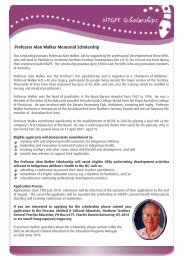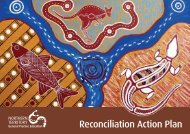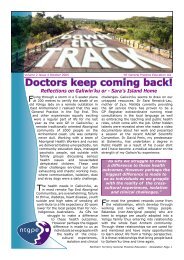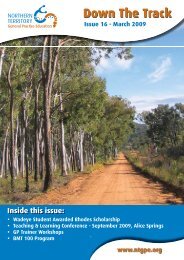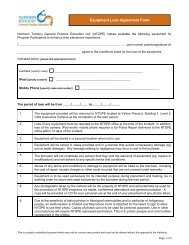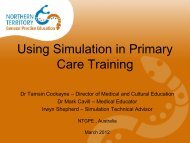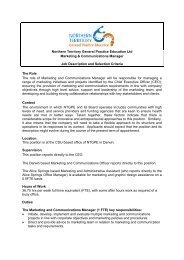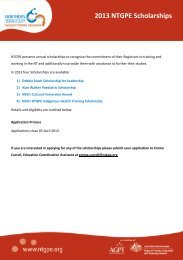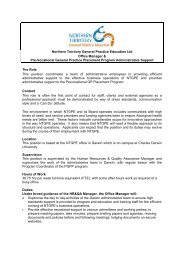Annual Report - ntgpe
Annual Report - ntgpe
Annual Report - ntgpe
Create successful ePaper yourself
Turn your PDF publications into a flip-book with our unique Google optimized e-Paper software.
General Practice Training ProgramAs part of a marketing focus NTGPE continues to promoteto interstate general pathway GPRs, the opportunity toundertake their rural rotation in the Northern Territory.The positive feedback received is encouraging alongwith a growth in numbers from previous training years.During 2010 GPRs undertook a variety of extended(special) skills posts both domestically and overseas,Advanced Rural Skills Post (ARSP) (RACGP) and advancedspecialised training (AST) (ACRRM). NTGPE medicaleducators continue to work with Registrars to developinteresting and sometimes complex posts. Registrarsengaged in Extended Skills posts training in the areasof emergency medicine, obstetrics and gynecology,military medicine, refugee medicine and psychiatry.Training undertaken by GPRs through ARSPs and ASTsincluded Indigenous population health, anaesthetics,paediatrics and obstetrics.No. of GPRs commencing the followingterms in 2010:Advanced Rural Skills Post (RACGP) 0(12mths)Advanced Specialised Training (ACRRM) 2(12mths)ARSP & AST combined (12mths) 0Extended (Special) Skills post (6mths) 9Optional Electives 2Nationally the GPR training program experienced anincrease in funded positions for the 2010 cohort. Therewere 748 training places available, an increase of 73from the previous year. Of the 1010 eligible applicationsreceived by GPET, 749 applicants accepted positionscompared to 671 in 2009. NTGPE had an increase of1 rural pathway position taking our training positionsavailable to 23 with 18 new GPRs commencing trainingin the 2010 training year.The selection process continues to be managednationally by GPET until the final interviews. NTGPE’spreferred method of interviewing is using the multiplemini interview style (MMI) for selection of Registrars.Applicants complete a circuit of seven or eight,10-minute mini-interview stations, rotating througheach station to respond to questions.The MMI method increases reliability and reducesinterviewer bias in the selection process. A drawback tothe process is it requires a minimum of four applicants,as such NTGPE has only been able to utilise the methodin round one interviews as subsequent rounds generallyhave less than four applicants. Face to face interviewsremain NTGPE’s ideal style as the process is more robustallowing for interviewers to get a stronger feel for anapplicant’s knowledge, skills and attitudes for rural /remote GPR training. All interviews conducted involvedseveral of NTGPE’s Medical and Aboriginal CulturalEducators.Registrars Intake 2010 CohortPathway Quota Filled % ofQuotaGeneralPathwayRuralPathwayComments7164145787.522 2 applicantswere allocatedto interview1 chose not tobe interviewedADF 0 1Totals 23 18 78.261 offerwithdrawn1 declined offer1 unsuccessful atinterview1 ADF applicants are not counted within the Quotaprovided by GPET2 7 applicants were living in the NT at the time ofapplication16 Northern Territory General Practice Education



